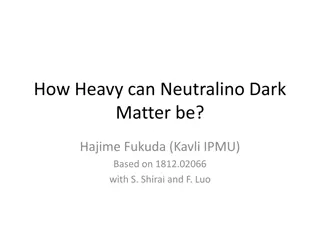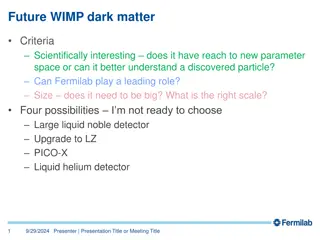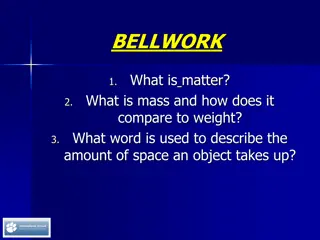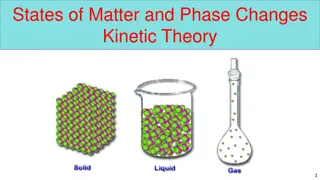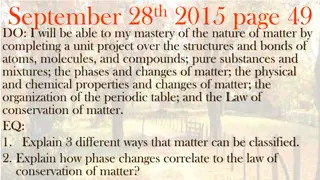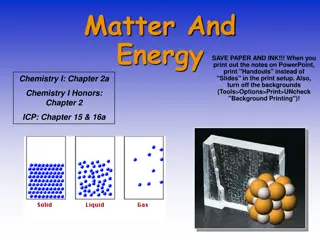Understanding Matter in Our Surroundings
Matter in Our Surroundings discusses the classification of matter, physical nature of matter, and the properties of matter particles such as size, space between them, and continuous movement. It explains how matter is made up of particles and how they interact with each other through various activities.
Download Presentation

Please find below an Image/Link to download the presentation.
The content on the website is provided AS IS for your information and personal use only. It may not be sold, licensed, or shared on other websites without obtaining consent from the author. Download presentation by click this link. If you encounter any issues during the download, it is possible that the publisher has removed the file from their server.
E N D
Presentation Transcript
MATTER IN OUR SURROUNDINGS Prepared By Prepared By- - Ashok Kumar Kushwaha Ashok Kumar Kushwaha TGT Science TGT Science K. V. Banka K. V. Banka
1A) MATTER :- Matter is anything which occupies space and has mass. b) Classification of matter :- i)Early Indian philosophers classified in the form of five basic elements as air, earth, fire, sky and water called Panch Tatva. ii)On the basis of the physical state matter is classified as solids, liquids and gases. iii)On the basis of chemical composition matter is classified as pure substances and mixtures. Pure substances may be elements or compounds. Mixtures may be homogeneous mixtures or heterogeneous mixtures.
2) PHYSICAL NATURE OF MATTER :- i) Matter is made up of particles. ii) The particles of matter are very tiny. iii) The particles of matter have space between them. iv) The particles of matter are continuously moving. v) The particles of matter attract each other. a) Matter is made up particles :- Activity :- Take some water in a beaker and note its level. Dissolve some salt or sugar in it with the help of a glass rod. The salt dissolves in the water but the level of water does not change. This is because the particles of water get into the space between the particles of water. This shows that matter is made up of particles.
B) THE PARTICLES OF MATTER ARE VERY TINY :- Activity :- Dissolve 2 3 crystals of potassium permanganate in 100ml of water in a beaker. Take 10ml of this solution and dissolve in 100ml of water. Take 10ml of this solution and dissolve in 100ml of water. Repeat this process 5 6 times. This shows that a few crystals of potassium permanganate can colour a large volume of water because there are millions of tiny particles in each crystal. 10ml 10ml 10ml I00ml 100ml 100ml 100ml
C) THE PARTICLES OF MATTER HAVE SPACE BETWEEN THEM :- Activity :- Take some water in a beaker and note its level. Dissolve some salt or sugar in it with the help of a glass rod. The salt dissolves in the water but the level of water does not change. This is because the particles of salt get into the space between the particles of water.
D) PARTICLES OF MATTER ARE CONTINUOUSLY MOVING :- Activity :- Take some water in a beaker and put a drop of blue or red ink slowly along the sides of the beaker. Leave it undisturbed for a few hours. The ink spreads evenly throughout the water due to the movement of the particles of water and ink. The intermixing of two or more different types of matter on their own is called diffusion.
E) PARTICLES OF MATTER ATTRACT EACH OTHER :- Activity :- Take an iron nail, a piece of chalk and a rubber band. Try breaking them by hammering, cutting or stretching. It is more easier to break the chalk, less easier to break the rubber band and difficult to break the iron nail. This is because the particles in the iron nail are held together with greater force than in the rubber band or chalk.
3) STATES OF MATTER :- Matter exists in three different states. They are :- i) Solid ii) Liquid iii) Gas a) Properties of solids :- i) Solids have definite shapes and fixed volume. ii) The space between the particle is minimum. iii) The force of attraction between the particles is maximum. iv) The movement of the particles is minimum. v) They are least compressible. vi) Their rate of diffusion is least.
B) PROPERTIES OF LIQUIDS :- i) Liquids have no definite shape but have fixed volume. Liquids take the shape of the container. ii) The space between the particles is intermediade. iii) The force of attraction between the particles is intermediate. iv) The movement of the particles is intermediate. v) They are less compressible. vi) Their rate of diffusion is more than solids.
C) PROPERTIES OF GASES :- i) Gases have no definite shape or fixed volume. Gases occupy the whole space of the container. ii) The space between the particles is maximum. iii) The force of attraction between the particles is minimum. iv) The movement of the particles is maximum. v) They are most compressible. vi) Their rate of diffusion is more than solids and liquids.
4) CHANGE OF STATE :- When a solid is heated it changes into liquid. When a liquid is heated it changes into gas. When a gas is cooled it changes to liquid. When a liquid is cooled it changes into solid. Eg:- If ice is heated it changes into water. If water is heated it changes into steam. If steam is cooled it changes into water. If water is cooled it changes into ice. Heat Cool Heat Cool Solid state Liquid state Gaseous state
A) MELTING (FUSION) :- When a solid is heated, the particles begin to vibrate with greater speed and begin to move more freely. Then at a particular temperature the solid melts and changes into liquid. The process of melting is also known as fusion. The temperature at which a solid melts is called its melting point. The melting point of ice is 00C or 273 K. Latent heat of fusion :- The amount of heat energy required to change 1kg of a solid into liquid at atmospheric pressure at its melting point is called the latent heat of fusion.
B) BOILING :-When a liquid is heated, its particles begin to move even faster. Then at a particular temperature the liquid begins to boil and changes into gas (vapour). Boiling is a bulk phenomenon. When a liquid boils the bulk of the liquid changes into vapour. The temperature at which a liquid starts boiling is called its boiling point. The boiling point of water is 1000C or 373K ( 273 + 100). Latent heat of vaporisation :- The amount of heat energy required to change 1kg of a liquid into gas at atmospheric pressure at its boiling point is called the latent heat of vaporisation.
C) SUBLIMATION :- The change of state directly from solid to gas or from gas to solid is called sublimation. Eg :- If solid camphor or ammonium chloride is heated, it changes into vapour. If the vapours are cooled it changes into solid. Cotton Inverted funnel Ammonium chloride solidified Ammonium chloride vapours China dish Ammonium chloride Ammonium chloride Burner
D) EFFECT OF PRESSURE ON GASES :- When pressure is applied on gas the particles come closer and the gas changes into liquid. We can liquefy gases by applying pressure and reducing the temperature. Compressed solid carbon dioxide is called dry ice. If the pressure is reduced it changes directly to gas without coming into liquid state. So solid carbon dioxide is known as dry ice.
5) INTERCONVERSION OF THE THREE STATES OF MATTER :- THE STATES OF MATTER ARE INTER CONVERTIBLE. THE STATE OF MATTER CAN BE CHANGED BY CHANGING THE TEMPERATURE OR PRESSURE. Solid Vaporisation Gas Liquid Condensation
The change of a liquid into vapour at any temperature below its 6A) EVAPORATION :- boiling point is called evaporation. Evaporation is a surface phenomenon. Particles from the surface gain enough energy to overcome the forces of attraction and changes to vapour state. b) Factors affecting evaporation :- The rate of evaporation depends upon surface area, temperature, humidity and wind speed. Increase in the surface area increases the rate of evaporation. Increase in temperature increases the rate of evaporation. Increase in humidity decreases the rate of evaporation. Increase in wind speed increases the rate of evaporation.
C) EVAPORATION CAUSES COOLING :- When a liquid evaporates, the particles of the liquid absorb heat from the surroundings and evaporates. So the surroundings become cold. Eg :- People sprinkle water on the roof or open ground because during evaporation water absorbs heat makes the hot surface cool. During summer we sweat more because during evaporation the sweat absorbs heat from our body making the body cool. Wearing cotton clothes in summer keeps us cool because cotton absorbs sweat and when the sweat evaporates it absorbs heat from our body making the body cool.
DESERT COOLER





